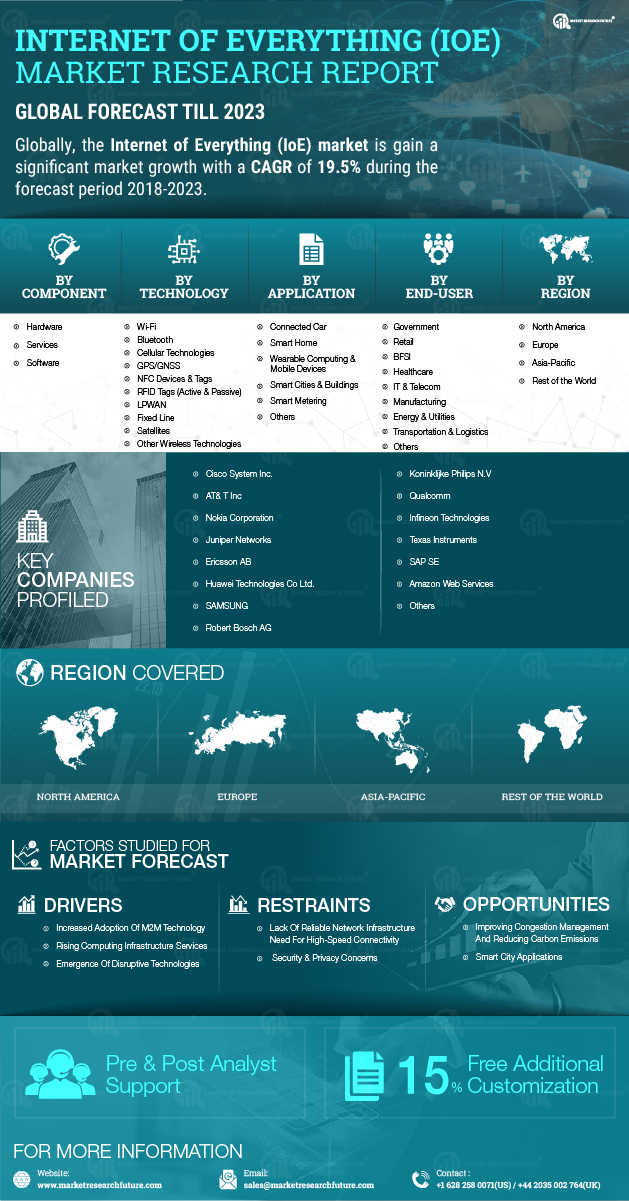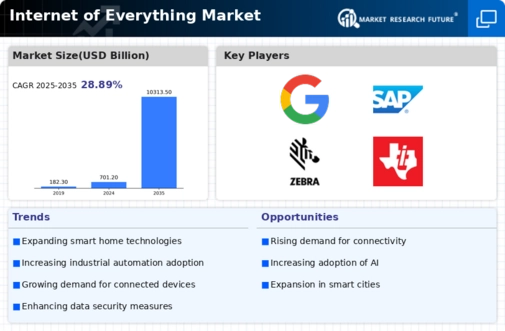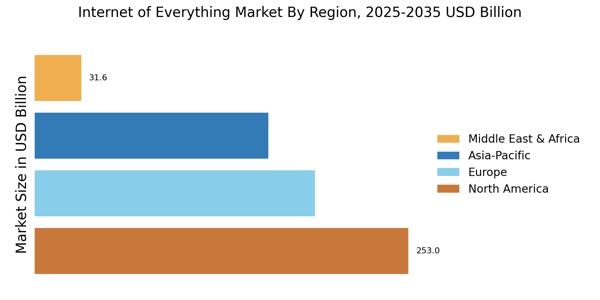Emergence of Smart Cities
The development of smart cities is a transformative trend driving the Internet of Everything Market. Urban areas are increasingly adopting IoT solutions to improve infrastructure, enhance public services, and promote sustainability. In 2025, investments in smart city initiatives are expected to reach over 500 billion, highlighting the potential for growth in this sector. Smart city technologies, such as intelligent transportation systems and energy-efficient buildings, rely on interconnected devices to optimize resource usage and improve quality of life for residents. As cities continue to evolve into smart ecosystems, the Internet of Everything Market is likely to experience significant expansion, driven by the demand for innovative urban solutions.
Increased Adoption of Smart Devices
The proliferation of smart devices is a primary driver of the Internet of Everything Market. As consumers and businesses increasingly adopt smart technologies, the demand for interconnected devices rises. In 2025, it is estimated that the number of connected devices will reach approximately 30 billion, significantly enhancing the scope of the Internet of Everything Market. This surge in device adoption not only facilitates seamless communication but also fosters innovative applications across various sectors, including healthcare, manufacturing, and smart cities. The integration of smart devices into everyday life is likely to create new revenue streams and business models, thereby propelling the Internet of Everything Market forward.
Advancements in Artificial Intelligence
Artificial intelligence (AI) is transforming the Internet of Everything Market by enabling smarter decision-making and automation. The integration of AI technologies into IoT systems allows for real-time data analysis and predictive analytics, enhancing operational efficiency. In 2025, the AI market is projected to reach over 190 billion, indicating a robust growth trajectory that will likely influence the Internet of Everything Market. AI-driven solutions can optimize resource management, improve customer experiences, and facilitate proactive maintenance in various industries. As organizations increasingly leverage AI capabilities, the Internet of Everything Market is expected to witness substantial growth, driven by enhanced functionality and intelligence.
Growing Demand for Enhanced Data Security
As the Internet of Everything Market expands, the need for robust cybersecurity measures becomes increasingly critical. With the rise in connected devices, vulnerabilities to cyber threats also escalate. In 2025, the cybersecurity market is anticipated to exceed 300 billion, reflecting the urgent need for advanced security solutions. Organizations are investing in comprehensive security frameworks to protect sensitive data and maintain consumer trust. This heightened focus on cybersecurity not only safeguards the integrity of interconnected systems but also fosters confidence in the Internet of Everything Market. Consequently, the demand for secure IoT solutions is likely to drive market growth, as businesses prioritize data protection.
Integration of IoT in Industrial Applications
The integration of IoT technologies into industrial applications is a significant driver of the Internet of Everything Market. Industries such as manufacturing, logistics, and energy are increasingly adopting IoT solutions to enhance operational efficiency and reduce costs. In 2025, it is projected that the industrial IoT market will surpass 100 billion, underscoring the growing reliance on interconnected systems. By leveraging IoT technologies, organizations can monitor equipment performance, optimize supply chains, and implement predictive maintenance strategies. This trend not only streamlines operations but also contributes to sustainability efforts, making the Internet of Everything Market a pivotal component of modern industrial practices.

















